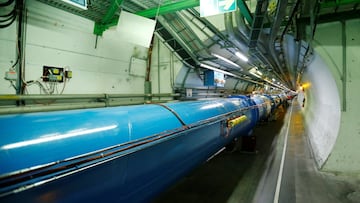How much money did CERN’s Large Hadron Collider cost to build and who paid for it?
On Tuesday 5 July, on the Franco-Swiss border near Geneva, Switzerland, we witnessed the turning back on of the Higgs boson discover.

You could feel the excitement in the room... even if watching via a small screen on the other side of the world. Yes, it was another big day on Tuesday as CERN restart the Large Hadron Collider (LHC) after more than three years of maintenance and upgrades. Despite the pause, work continued apace and with much of the functional insight and terminology used a little confusing to most of us mortals, the financial numbers that fund the project is much more understandable, if equally hard to digest for some.
Before we look at the actual cost of the LHC, let’s get some of the basics out of the way.
What is the Large Hadron Collider?
Have you ever been sat watching the football and thought to yourself, ‘I wonder what a particle accelerator that pushes protons or ions to near the speed of light looks like’? Well, if you have, then the LHC is your answer.
Sitting on the Franco-Swiss border near Geneva, Switzerland, it consists, as CERN explains, ‘of a 27-kilometre [about 17 miles] ring of superconducting magnets with a number of accelerating structures that boost the energy of the particles along the way’. Think of a huge donut with sugar dust being chased around by a hungry Homer Simpson.
How does the Large Hadron Collider actually work?
Once again, for the answer to this question, who better to articulate it than the European Organization for Nuclear Research itself.
The CERN accelerator complex is a succession of machines with increasingly higher energies. Each machine accelerates a beam of particles to a given energy before injecting the beam into the next machine in the chain. This next machine brings the beam to an even higher energy and so on. The LHC is the last element of this chain, in which the beams reach their highest energies.
The aforementioned gap period was known as the Long Shutdown 2 (LS2), and since then, experts have worked around the clock to progressively recommission the machine and safely ramp up the energy and intensity of the beams before delivering collisions to the LHC experiments at the world-record energy of 13.6 trillion electronvolts (13.6 TeV). These high-energy collisions with stable beams will mark the beginning of the third run of the LHC, called Run 3.
So to the euros, pounds and dollars behind the whole thing...
The cost of CERN’s Large Hadron Collider
It took around 10 years to build the LHC and the overall cost of that creation is said to have been around $4.75 billion. That’s about the valuation of the New England Patriots!
Ongoing costs are split across various projects with the CMS and ATLAS Detectors - those responsible for the Higgs boson discovery, which is estimated to have cost over $13 billion in total - being responsible for around $5.5 billion a year. CERN contributes approximately one fifth of that cost with the rest coming from other international organisations.
Add to that the $286 million for computing power each year and then electricity for the LHC comes in annually at about $23.5 million. All in all, you’re looking in the region of $1 billion per year in operating budget. As you can see, it ain’t cheap to find out the origins of our universe, but for those less interested in that, don’t worry, there are plenty of current medical advances also being made through these experiments.
Who pays for CERN research?
It is CERN member countries that fund the program, with just over 70% of the annual budget given by Germany, the United Kingdom, Italy, France and Spain. Other contributors include the governments of the United States, India, and Russia, as well as various universities and other large organisations.






